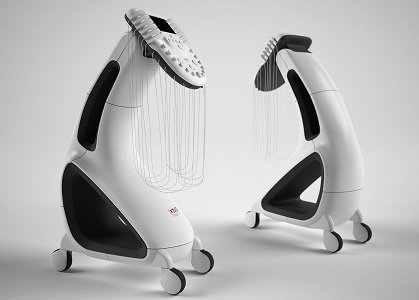Rapid revolution in medicine, and at the center of it all lies biomedical engineering that improves healthcare. Biomedical imaging technology, driven by these innovations, peers into the human body to help implant implantable life-saving devices to mend a damaged heart. Buckle up! Let’s join you in exploring the complex patterns that inform biomedical engineering products together and see how these innovative directions will redefine the delivery of patient care. Be prepared to be inspired. The brightest thinkers and breakthroughs in technology are revolutionizing the medical world. In the end, the destiny of the healthcare enterprise has dawned on humans, and nothing might be extra impressive.
Artificial Intelligence and Machine Learning
Still, AI and ML technologies have changed the course of many initiatives, and biomedical engineering is no exception. These large-scale medical data analyses assist in building diagnostic tools, personalized treatments, and disease models. Biomedical AI tools could aid in better diagnosis, optimized treatments, and improved patient outcomes.
3D Printing and Bioprinting
Today, 3D printing manufactures customized prosthetics, implants, and surgical guides. Advanced biomedical engineering improved the treatments better for the patient and minimized complications. ‘Bioprinting’ is named after the 3D printing of living cells and biomaterials. That’s just the beginning; it will revolutionize organ transplants and regenerative medicine shortly.
Wearable Devices and Remote Patient Monitoring
Wearable devices and the RPM system are now entering a high-demand era. Biomedical engineering products that continuously track vital signs and health metrics help in the early detection of health problems, making rapid interventions possible. Future health care will depend on wearable devices and the RPM system. They will support preventive care and empower patients.
Robotics and Minimally Invasive Surgery
MIS and robotics have revolutionized the field of surgery. Robotic systems enhance surgeons’ precision, skill, and agility of vision. They enable surgeons to conduct more precise and less invasive surgical procedures. With the amalgamation of MIS and robotics, patients receive treatment requiring shorter hospitalization periods, minimal agony, and rapid recovery.
Point-of-Care Diagnostics
POC diagnosis comprises:
- Diagnostic testing at the location of the patient.
- Generating fast money.
- Speed action facilitation.
Biomedical products at POC range from glucose monitors to disease test systems. All are handheld and portable, useful for remote areas where lab access is impossible.
Nanotechnology and Drug Delivery
Nanotechnology involves using material at the atomic and molecular levels. Today, research is being carried out in biomedical engineering. Its applications provide various benefits, such as improved usage, site-specific drug release support, and advances in imaging techniques. Since nanoparticles are used to deliver drugs, they will be very efficient in treating specific cells and have minimal side effects.
- Nanotechnology refers to the controlled manipulation of materials at the nanolevel.
- Its capability to provide accurate medical tests and treatments will contribute to biomedical engineering.
- Drugs encapsulated in nanoparticles can be released at a specific time.
- Concentrated drug monitoring reduces adverse side effects and improves treatment efficiency.
- Nanotechnology has tremendous potential in furthering medical imaging and also regenerative medicine.
Personalized Medicine
It individualizes care based on a patient’s genetic characteristics, lifestyle, and other issues. Biomarkers and genetic differences can already be identified through genomics and biomedical engineering. They affect susceptibility to disease, its course, and response to treatment. This enables targeted therapies and preventive procedures to enhance patient prognosis.
Telemedicine and Virtual Care
The COVID-19 pandemic has advanced with the adoption of virtual care and telemedicine. These technologies apply biomedical engineering and communication tools. They offer remote consultations, diagnoses, and treatments. Telemedicine improves access to healthcare by improving health accessibility in rural areas, easing healthcare systems, and enhancing patient convenience.
Biomaterials and Tissue Engineering
The applications of biomaterials range from biomedical engineering to its products, including polymers, ceramics, and metals. It should create new tissues and organs by combining biomaterials with cells. Thus, techniques coupled with biomaterials and cells can overcome the vast challenges that organ transplantations and regenerative medicine face. It can also provide better medical implants and devices through technological advancement.
Data Analytics and Big Data
The healthcare industry generates enormous volumes of multifaceted and detailed information. It encompasses data, including health care records of patients, outcomes of clinical trials, and other conclusions drawn from research investigations. Data analytics and big data tools can uncover valuable insights into large volumes of information for healthcare professionals. These findings shall translate into new diagnostic tools, innovative treatments, and plans specific to the individual situation to predict disease progression. Data shall shape the course of biomedical engineering and healthcare and promote advancement in research, treatment, and patient management.
The Bottom Line
Biomedical engineering is a tapestry of innovation: new threads of discovery being woven into the very fabric of health care. We’ve seen enormous breadth and potential for ‘artificial intelligence’ and ‘machine learning, precision for personalized medicine, and invaluable insights through data analytics. Imagine a future when we can identify illnesses earlier so that each person gets treatments tailored just for them.
Now and forever, health care will be about prevention, not response. We’re talking about developments that will bring about these changes. We’ll innovate again as we move forward into what’s possible. They’re going to shift the way we attain health and wellness. The biomedical engineering products journey has just started. Its adventure, its history, is full of exciting possibilities. Let’s embrace what the future holds. It may be an even more healthy and happy world for their generation.
Also read out https://empireadda.com/benefits-of-keratin-treatments-what-you-should-know/



